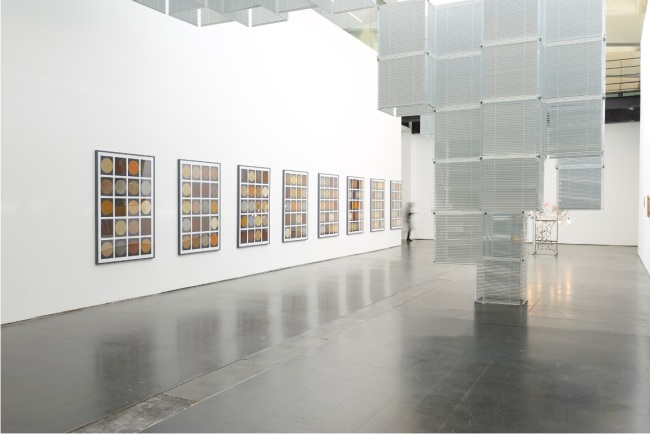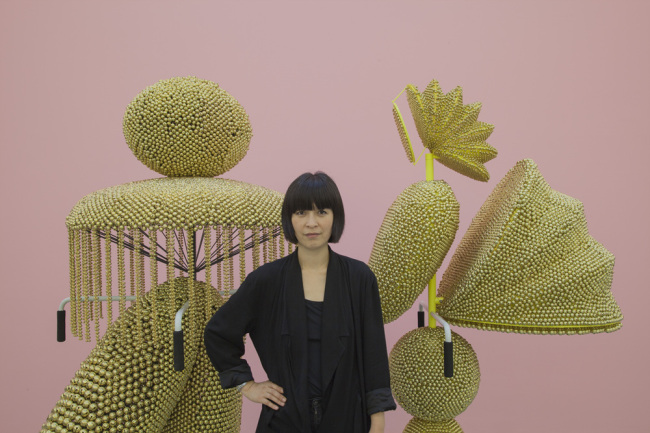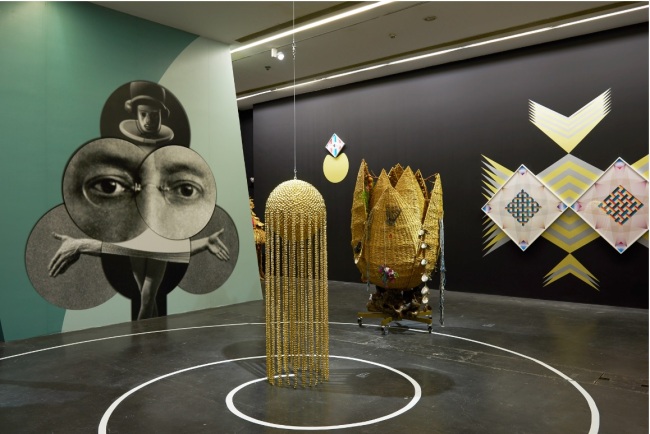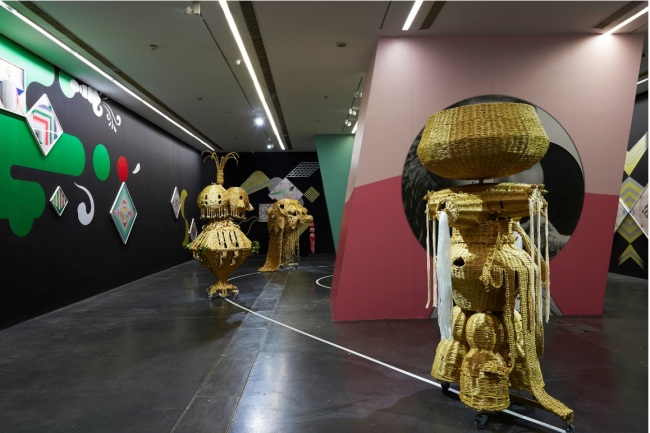[Herald Interview] Korean artist Yang Haegue holds first solo museum show in China
Exhibition shows mixture of diverse materials that look into Asian multiculturalism, diaspora
By 이우영Published : Nov. 2, 2015 - 17:55
BEIJING -- Artist Yang Haegue is one of the most visible Korean artists in the international art scene nowadays. Her works were exhibited at major Western art institutions, including the Museum of Modern Art and Guggenheim Museum in New York, the Modern Museum in Sweden, Vienna Biennale and Lyon Biennale -- all within this year.
She opened her first museum show in China on Oct. 30, bringing some 36 major works spanning from 1994 to the present, at the Ullens Center for Contemporary Art in Beijing.
She opened her first museum show in China on Oct. 30, bringing some 36 major works spanning from 1994 to the present, at the Ullens Center for Contemporary Art in Beijing.

“My expectation for the Chinese museum show is different from my previous ones,” said the 44-year-old artist, in an interview with The Korea Herald in Beijing.
It’s hard to detect her feelings from her low and calm voice. She carries Zen-like calmness and exudes a strong ambience from her signature black avant-garde clothes and black eyeliner.
“Two important exhibitions for me this year are in Beijing and Seoul,” she said. Yang held a semi-retrospective at the Samsung Museum of Art, Leeum in February this year, which was only her third exhibition in Korea.

Since she moved to Germany in 1994, Yang has mostly showcased her works in Europe, having emerged as an art star in the European art scene. Her fame abroad, in turn, opened exhibition opportunities in Asia.
The Chinese exhibition is a smaller version of her Seoul exhibition. But for the Chinese museum, it is the last section of the museum’s three-part exhibition series “Secret Timezones Trilogy” that sheds light on contemporary Asian artists who live and work outside their home country.
Yang’s installation pieces are displayed at two separate spaces -- the bright Nave Gallery and darker Central Gallery. But the exhibition starts right from the lobby of the museum with two stacks of Korean Choco Pies.
Wrapped in transparent plastic vinyl sheets, the popular Korean snack -- which has also been manufactured and sold in China since 1997 -- is similar to her presence in the Chinese art scene, Yang said.
“Chinese museums have usually allotted their space for Western artists or homegrown Chinese artists. There have been not really other foreign artists holding exhibitions here. It’s like Asians prefer to eat American Hershey’s, or their traditional snacks rather than choosing some unknown Asian brands,” said Yang.
For this exhibition, more than two years in the making, Yang took a friendly approach for Chinese audiences. She borrowed an idiom from a poem by Chinese Song Dynasty scholar Su Shi and named the exhibition “Come Shower or Shine, It Is Equally Blissful.”

Yang is known for her use of diverse materials and embedding social and cultural contexts in them. The exhibition features a mix of diverse materials -- spices, Venetian blinds, clothing racks, synthetic straw, Choco Pies, bells and graph paper, which all form uniquely harmonious visual presentations.
In the Nave Gallery hangs her signature Venetian blind installation “Sol LeWitt Upside Down -- K123456, Expanded 1078 Times, Doubled and Mirrored,” a commissioned piece for the exhibition space with a 9.4-meter high ceiling at the UCCA. On the right and left side are displayed unique paintings made with lacquer, chilies and spices.
The “Spice Moons” consists of eight framed panels of spice prints, through which the artist criticizes the notion of the homogenous identity of East Asians and highlights Asian multiculturalism. She bought 20 spices, such as curry, tamarind powder, black pepper and mustard at a supermarket in Singapore, known for its cultural and ethnic diversity.
“Spices used to be highly valuable that served as currency historically. The recipes for making spices we use now such as curry and tamarind powder is not made by one person. These recipes have evolved with collective knowledge by Asians,” Yang said.
“The East Asians from China and Korea and Japan has superiority over other Asians for their homogeneity. But historically, they are very multicultural, comprising diverse ethnicities.”
She presents “Totem Robots,” with their heads and arms draped with electric cables, light bulbs and other objects before viewers encounter her other anthropomorphic sculpture “The Intermediates” in the darker Central Gallery.

“The Intermediates” made with synthetic straw in the forms of bride and dancer, guide each step of visitors through the Central Gallery, entirely wrapped by wall decor with the paper collage series “Trustworthies.”
Here, the artist included one of her earlier pieces “Video Trilogy (2004-2006),” a video work featuring her monologue about moving from one place to another and the feeling of loneliness and disconnection. This work is based on Yang’s daily journals she kept since 1994 when she moved to Germany to study, after graduating from Seoul National University.
“Leaving home was very hard when the Internet wasn’t used as widely as today,” she said.
She regards the detachment from home a shared experience for many Asians. Through urbanization and globalization, people leave their rural hometowns to work in cities, study abroad or migrate to foreign countries.
“China has a lot of workers who moved from their rural hometowns to cities. Korea too has similar workers. Asia has its own history of detachment. I think many Asians can relate to this,” she said.
“Haegue Yang: Come Shower or Shine, It Is Equally Blissful” runs through Jan. 3 at the UCCA in Beijing. For more information, visit www.ucca.org.cn.
By Lee Woo-young (wylee@heraldcorp.com)


![[AtoZ into Korean mind] Humor in Korea: Navigating the line between what's funny and not](http://res.heraldm.com/phpwas/restmb_idxmake.php?idx=644&simg=/content/image/2024/04/22/20240422050642_0.jpg&u=)
![[Exclusive] Korean military set to ban iPhones over 'security' concerns](http://res.heraldm.com/phpwas/restmb_idxmake.php?idx=644&simg=/content/image/2024/04/23/20240423050599_0.jpg&u=20240423183955)



![[Graphic News] 77% of young Koreans still financially dependent](http://res.heraldm.com/phpwas/restmb_idxmake.php?idx=644&simg=/content/image/2024/04/22/20240422050762_0.gif&u=)
![[Herald Interview] Why Toss invited hackers to penetrate its system](http://res.heraldm.com/phpwas/restmb_idxmake.php?idx=644&simg=/content/image/2024/04/22/20240422050569_0.jpg&u=20240422150649)





![[Exclusive] Korean military to ban iPhones over security issues](http://res.heraldm.com/phpwas/restmb_idxmake.php?idx=652&simg=/content/image/2024/04/23/20240423050599_0.jpg&u=20240423183955)



![[Today’s K-pop] Ateez confirms US tour details](http://res.heraldm.com/phpwas/restmb_idxmake.php?idx=642&simg=/content/image/2024/04/23/20240423050700_0.jpg&u=)